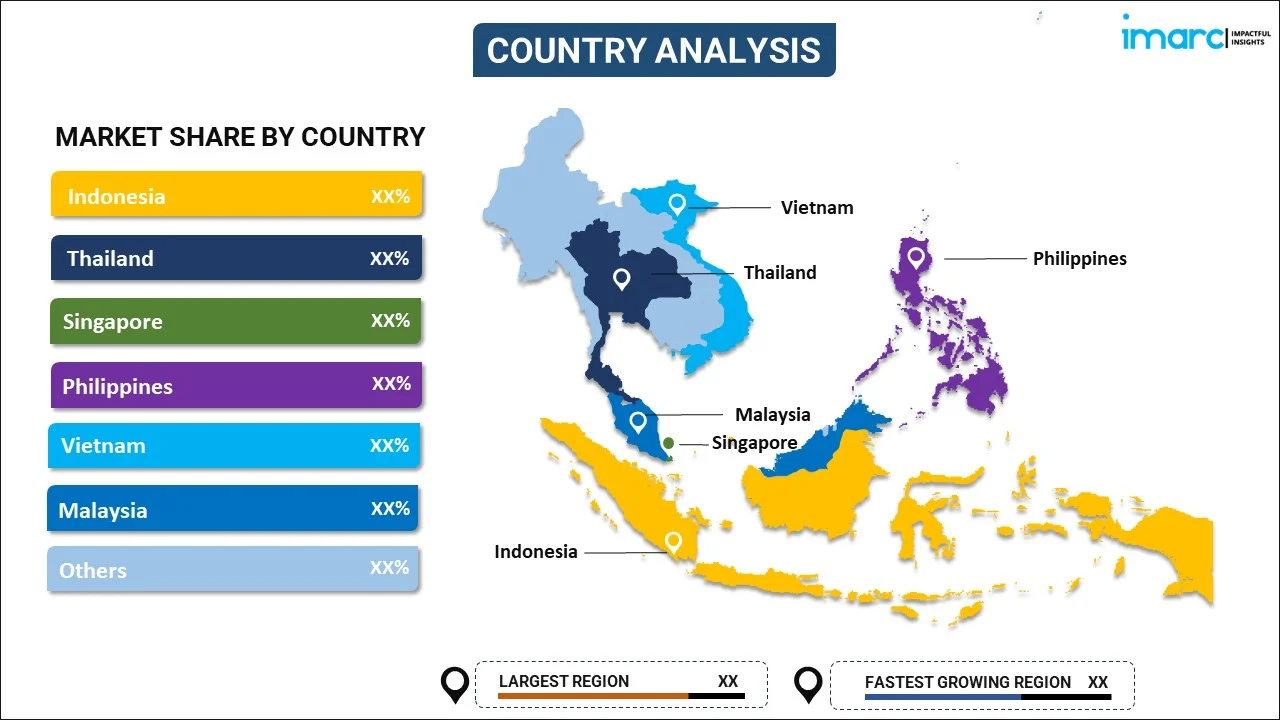
South East Asia 3D Display Market Report by Type (Volumetric Display, Stereoscopic, Head Mounted Displays), Technology (Digital Light Processing, Plasma Display Panel, Organic Light Emitting Diodes (OLEDs), Light Emitting Diode (LEDs)), Access Method (Conventional/Screen Based Display, Micro Displays), Application (Televisions, Smartphones, Monitors, Mobile Computing Devices, Projectors, and Others), and Country 2024-2032
Market Overview:
South East Asia 3D display market size is projected to exhibit a growth rate (CAGR) of 15.10% during 2024-2032. The growing integration into the infotainment systems and driver assistance features of vehicles, rising adoption in the entertainment sector, and increasing employment of advanced technologies in the healthcare sector for medical imaging and diagnostics represent some of the key factors driving the market.
|
Report Attribute
|
Key Statistics
|
|---|---|
|
Base Year
|
2023 |
|
Forecast Years
|
2024-2032
|
|
Historical Years
|
2018-2023
|
| Market Growth Rate (2024-2032) | 15.10% |
A 3D display is a technology that creates the illusion of depth in an image, making it appear three-dimensional to the viewer. It is typically manufactured using various methods, such as autostereoscopic technology, which eliminates the need for special glasses, or stereoscopic technology that relies on specialized glasses to achieve the 3D effect. It involves the creation of multiple perspectives of an image, either through lenticular lenses or polarization, which are then combined to provide depth perception. It is available in several types, including autostereoscopic or glasses-free and stereoscopic displays that require glasses, each with its own advantages and limitations. It offers numerous advantages, such as improved engagement, better visualization of complex data, and enhanced learning experiences. It enhances the viewing experience in various industries, including entertainment, gaming, healthcare, and engineering.
South East Asia 3D Display Market Trends:
At present, the rising adoption of 3D technology in the entertainment sector to provide better image quality and enhance user engagement represents one of the major factors impelling the growth of the market in South East Asia. The increasing popularity of streaming platforms is driving the demand for 3D displays that can provide more immersive and captivating experiences. Moreover, the growing integration of 3D displays into the infotainment systems and driver assistance features of vehicles is positively influencing the market in the region. These displays provide drivers with enhanced visibility and navigation assistance, contributing to improved safety and overall driving experience. Apart from this, the rising employment of 3D displays in the healthcare sector for medical imaging and diagnostics is bolstering the market growth in the region. This 3D imaging technology offers medical professionals a more detailed and accurate view of patient scans and allows for better surgical planning and precision. In addition, the increasing utilization of glasses-free 3D displays in the retail and advertising industries to create a more engaging shopping experience and enable advertisers to showcase products more interactively is propelling the market growth. Besides this, the growing development of augmented reality (AR) and virtual reality (VR) applications, which rely on 3D displays to create immersive virtual environments, is offering a favorable market outlook in the region. Additionally, the increasing adoption of 3D displays in the education sector as a tool for interactive and immersive learning is contributing to the growth of the market in the region. These educational institutions are recognizing the value of 3D technology in enhancing student engagement and comprehension, especially in subjects like science and geography.
South East Asia 3D Display Market Segmentation:
IMARC Group provides an analysis of the key trends in each segment of the market, along with forecasts at the regional and country levels for 2024-2032. Our report has categorized the market based on type, technology, access method, and application.
Type Insights:

- Volumetric Display
- Stereoscopic
- Head Mounted Displays
The report has provided a detailed breakup and analysis of the market based on the type. This includes volumetric display, stereoscopic, and head mounted displays.
Technology Insights:
- Digital Light Processing
- Plasma Display Panel
- Organic Light Emitting Diodes (OLEDs)
- Light Emitting Diode (LEDs)
A detailed breakup and analysis of the market based on the technology have also been provided in the report. This includes digital light processing, plasma display panel, organic light emitting diodes (OLEDS), and light emitting diode (LEDS).
Access Method Insights:
- Conventional/Screen Based Display
- Micro Displays
The report has provided a detailed breakup and analysis of the market based on the access method. This includes conventional/screen based display and micro displays.
Application Insights:
- Televisions
- Smartphones
- Monitors
- Mobile Computing Devices
- Projectors
- Others
A detailed breakup and analysis of the market based on the application have also been provided in the report. This includes televisions, smartphones, monitors, mobile computing devices, projectors, and others.
Country Insights:

- Indonesia
- Thailand
- Singapore
- Philippines
- Vietnam
- Malaysia
- Others
The report has also provided a comprehensive analysis of all the major regional markets, which include Indonesia, Thailand, Singapore, Philippines, Vietnam, Malaysia, and Others.
Competitive Landscape:
The market research report has also provided a comprehensive analysis of the competitive landscape in the market. Competitive analysis such as market structure, key player positioning, top winning strategies, competitive dashboard, and company evaluation quadrant has been covered in the report. Also, detailed profiles of all major companies have been provided.
South East Asia 3D Display Market Report Coverage:
| Report Features | Details |
|---|---|
| Base Year of the Analysis | 2023 |
| Historical Period | 2018-2023 |
| Forecast Period | 2024-2032 |
| Units | US$ Million |
| Scope of the Report | Exploration of Historical and Forecast Trends, Industry Catalysts and Challenges, Segment-Wise Historical and Predictive Market Assessment:
|
| Types Covered | Volumetric Display, Stereoscopic, Head Mounted Displays |
| Technologies Covered | Digital Light Processing, Plasma Display Panel, Organic Light Emitting Diodes (OLEDs), Light Emitting Diode (LEDs) |
| Access Methods Covered | Conventional/Screen Based Display, Micro Displays |
| Applications Covered | Televisions, Smartphones, Monitors, Mobile Computing Devices, Projectors, Others |
| Countries Covered | Indonesia, Thailand, Singapore, Philippines, Vietnam, Malaysia, Others |
| Customization Scope | 10% Free Customization |
| Report Price and Purchase Option | Single User License: US$ 3699 Five User License: US$ 4699 Corporate License: US$ 5699 |
| Post-Sale Analyst Support | 10-12 Weeks |
| Delivery Format | PDF and Excel through Email (We can also provide the editable version of the report in PPT/Word format on special request) |
Key Questions Answered in This Report:
- How has the South East Asia 3D display market performed so far and how will it perform in the coming years?
- What has been the impact of COVID-19 on the South East Asia 3D display market?
- What is the breakup of the South East Asia 3D display market on the basis of type?
- What is the breakup of the South East Asia 3D display market on the basis of technology?
- What is the breakup of the South East Asia 3D display market on the basis of access method?
- What is the breakup of the South East Asia 3D display market on the basis of application?
- What are the various stages in the value chain of the South East Asia 3D display market?
- What are the key driving factors and challenges in the South East Asia 3D display?
- What is the structure of the South East Asia 3D display market and who are the key players?
- What is the degree of competition in the South East Asia 3D display market?
Key Benefits for Stakeholders:
- IMARC’s industry report offers a comprehensive quantitative analysis of various market segments, historical and current market trends, market forecasts, and dynamics of the South East Asia 3D display market from 2018-2032.
- The research report provides the latest information on the market drivers, challenges, and opportunities in the South East Asia 3D display market.
- Porter's five forces analysis assist stakeholders in assessing the impact of new entrants, competitive rivalry, supplier power, buyer power, and the threat of substitution. It helps stakeholders to analyze the level of competition within the South East Asia 3D display industry and its attractiveness.
- Competitive landscape allows stakeholders to understand their competitive environment and provides an insight into the current positions of key players in the market.
Need more help?
- Speak to our experienced analysts for insights on the current market scenarios.
- Include additional segments and countries to customize the report as per your requirement.
- Gain an unparalleled competitive advantage in your domain by understanding how to utilize the report and positively impacting your operations and revenue.
- For further assistance, please connect with our analysts.

 Inquire Before Buying
Inquire Before Buying
 Speak to an Analyst
Speak to an Analyst
 Request Brochure
Request Brochure
 Request Customization
Request Customization



.webp)




.webp)












